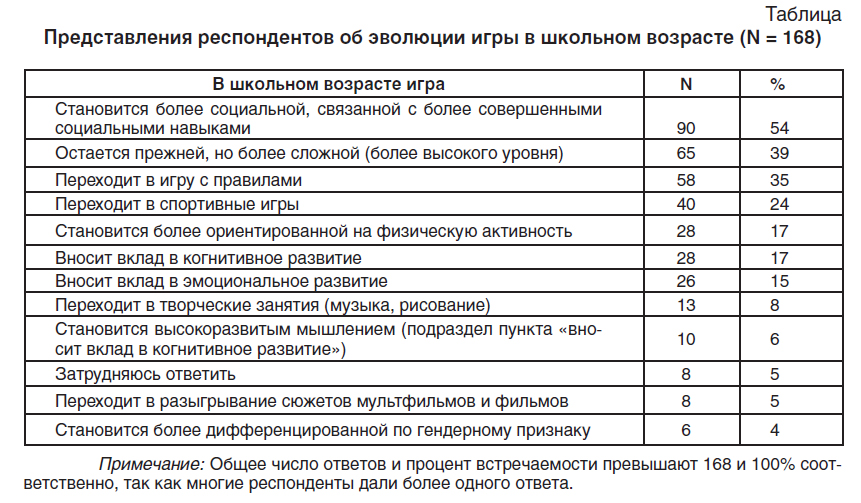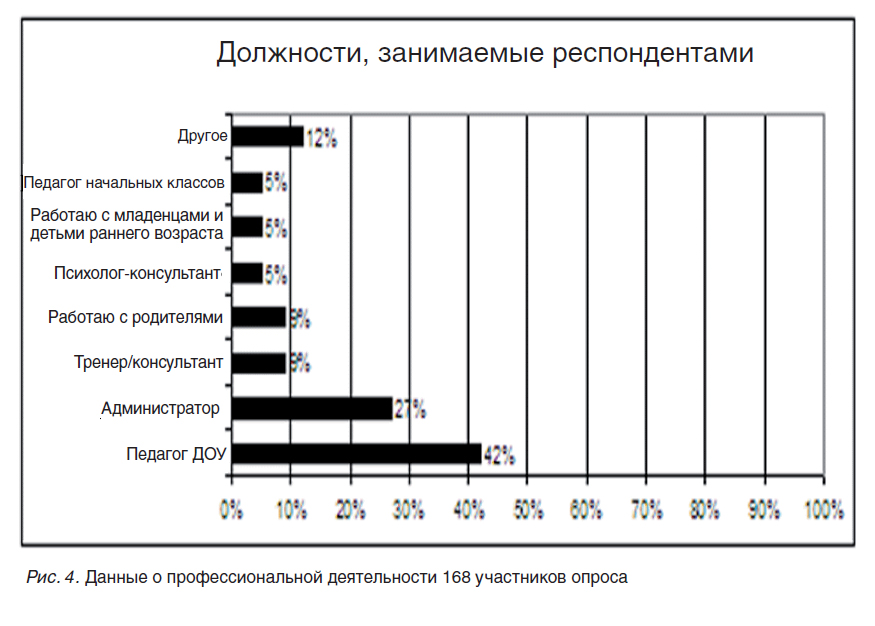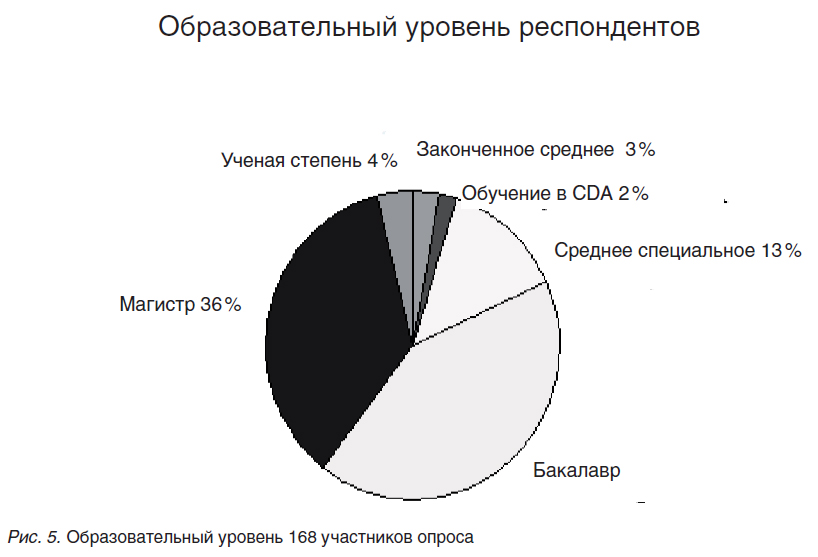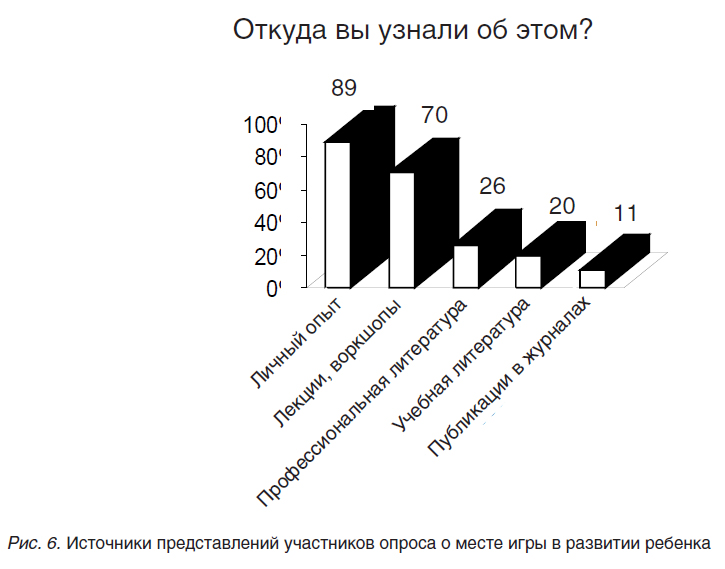Одновременно с усиливающейся тенденцией вытеснения игры из системы образования как «избыточного» элемента все большее число специалистов в психологии развития, педагогов, педиатров, правозащитников, нейрофизиологов и их коллег из других областей работы с детьми доказывают, что игре принадлежит фундаментальная, жизненно важная роль в развитии человека, что депривация игровой деятельности в раннем возрасте разрушительна для нормального развития [Bergen, 2001; Brown, 2009; Copple, 2009; Elkind, 2003; Ginsburg, 2007; Hirsh-Pasek, 2009; Singer, 2006; Isenberg, 2002; Miller, 2009; Porges, 2003; Porges, 2009; Zigler, 2004; Singer, 2004].
В данной работе дается анализ причин указанного противоречия, представлена новая концепция роли игры в развитии, основанная в первую очередь на работах Л. С. Выготского и его последователей и создающая теоретическое обоснование центральной роли игры в учебной программе для дошкольников.
Общепринятые представления о траектории развития игры
Большинство теорий о роли игры в когнитивном развитии описывает путь от исследовательской активности и манипулирования с предметами в младенчестве и раннем возрасте к социальной игре-драматизации и конструированию у дошкольников, а затем – к играм по правилам, спортивным играм и досуговой деятельности подростков и взрослых [Piaget, 1962; Smilansky, 1968; Vygotsky, 1933].
В ряде теоретических работ, обзоров и иных публикаций игра рассматривается как способ успешного овладения социальными навыками [Berk, 2006; Coplan, 2006; Piaget, 1926; Piaget, 1932; Rubin, 1977; Rubin]. Этот «общепринятый» взгляд на игру можно встретить в большинстве книг на эту тему, в учебниках по психологии развития. Фокусируясь на роли игры в социальном развитии, они в лучшем случае приводят краткую справку о ее значении для когнитивной сферы. Например, часто используемый учебник Лауры Э. Берк посвящает описанию последовательности этапов игры с точки зрения когнитивного развития [Berk, 2006, p. 599] в разделе под названием «Сверстники, окружение и обучение в школе». В нем перечисляются четыре этапа в последовательности их развития: манипулирование, конструирование, игра «понарошку» и игры с правилами, ссылаясь на главу из книги, написанной Рубиным в 1983 году.
В книге, вышедшей под редакцией Д. Фромберга и Д. Берген, последняя
пишет:
«Формы игры трансформируются на протяжении всего детства, превращаясь в
нечто отличное от игры, в «отдых» или «досуговую деятельность» взрослых.
Реплики и игровые действия все больше интернализируются, а некоторые виды игр
становятся скорее серьезными и соревновательными, нежели развлекательными» [23,
p. хvii].
В ряде книг, посвященных развитию детей, вообще умалчивается о траектории развития игры. Например, в книге Роберта Фельдмана «Развитие ребенка» [Feldman, 2007] игра не упоминается ни до, ни после раздела, посвященного дошкольному возрасту, хотя в широком смысле игра охватывает все детство, от пренатального периода до подростничества. У читателя, скорее всего, создается впечатление, что игра – это некий артефакт, бросающийся в глаза в дошкольном возрасте, но не являющийся значимым для развития.
В он-лайн опросе, направленном на выяснение, разделяют ли специалисты в США этот «общепринятый» взгляд на игру, 168 специалистов из 9 штатов должны были закончить предложение: «В школьном и подростковом возрасте игра преобразуется в…». Самым популярным был ответ, что игра приобретает более социальный характер и/или способствует развитию социальных навыков (90 из 168 респондентов). Шестьдесят пять респондентов полагают, что игра школьников похожа на игру в дошкольном возрасте, но она сложнее и более организована. Игры с правилами и спортивные игры были упомянуты 58 и 40 респондентами соответственно. И толь-ко 28 респондентов сказали, что игра преобразуется в высшие уровни познавательной деятельности, включая решение проблем, мышление и грамотность в широком смысле. Более подробно результаты данного опроса представлены в приложении (таблица и рис. 3–6). Итак, игра в раннем детстве чаще всего рассматривается как путь к социальному развитию и более сложным формам игры, третье и четвертое место по популярности было отдано играм с правилами и спортивным играм.
Л.С. Выготский об игре
В работе Л. С. Выготского «Игра и ее роль в психическом развитии ребенка» [Vygotsky, 1933] представлен тот же общепринятый взгляд на развитие игры. «Развитие от явной мнимой ситуации и скрытых правил к игре с явными правилами и скрытой мнимой ситуацией и составляет два полюса, намечает эволюцию детской игры». Также он утверждал, что «…у школьника игра начинает существовать в виде ограниченной формы деятельности, преимущественно типа спортивных игр, играющих известную роль в общем развитии школьника, но не имеющих того значения, которое имеет игра у дошкольника». Другие исследователи работ Л. С. Выготского, посвященных игре, соглашаются с ним. Дункан и Тарулли переформулируют идею Л. С. Выготского: «Ранняя социальная игра-драматизация – предпосылка для развития игры с правилами в старшем дошкольном и младшем школьном возрасте [16, с. 275]. С точки зрения Л. С. Выготского, правила являются основной темой, объединяющей игру в раннем и школьном возрастах. Он сосредоточил внимание на том, как они эволюционируют от имплицитных правил в драматической игре дошкольников к эксплицитным – в разнообразных видах деятельности школьников:
- «В конце развития выступает правило» [57, абзац 78].
- «К концу развития в игре выступает отчетливо то, что было в зародыше вначале. Выступает цель – правила» [57, абзац 79].
- «В школьном возрасте игра не умирает, а проникает в отношение к действительности. Она имеет свое внутреннее продолжение в школьном обучении и труде (обязательная деятельность с правилом)» [57, абзац 89].
- «Точно так же, как в начале удалось показать, что всякая мнимая ситуация содержит в скрытом виде правила, удалось показать и обратное – что всякая игра с правилами содержит в себе в скрытом виде мнимую ситуацию» [57, абзац 35].
Более того, Выготский писал и о том, что игра действительно развивает высшие психические функции: «Игра переходит к внутренним процессам в школьном возрасте, к внутренней речи, логической памяти, абстрактному мышлению» [57, абзац 57]. Он также утверждал, что «старую формулу, что детская игра есть воображение в действии, можно перевернуть и сказать, что воображение у подростка и школьника есть игра без действия» [57, абзац 16].
Далее в своей работе он отмечает: «Факт создания мнимой ситуации с точки зрения развития можно рассматривать как путь к развитию отвлеченного мышления». В данном тексте не проводится различия между новообразованием, возникающим в игре с правилами, и абстрактным мышлением.
Далее для понимания взглядов Л. С. Выготского на отношения между игрой и развитием абстрактного мышления обратимся к его эссе «Воображение и творчество», написанному в 1930 году, тремя годами ранее работы, посвященной игре (и опубликованному на английском языке в 1990 году).
«Игры ребенка очень часто служат только отголоском того, что он видел и слышал от взрослых, и тем не менее эти элементы прежнего опыта ребенка никогда не воспроизводятся в игре совершенно так же, как они представлялись в действительности. Игра ребенка не есть простое воспоминание о пережитом, но творческая переработка пережитых впечатлений, комбинирование их и построение из них новой действительности, отвечающей запросам и влечениям самого ребенка» [Vygotsky, 1990, с. 87].
Здесь Л. С. Выготский указывает, что воображение и творчество укоренены
в игре «понарошку», но они еще неокончательно сформированы и нуждаются в
материальной опоре. Т. А. Репина с коллегами [Repina, 1964] предложили теоретическое
обоснование и провели эксперименты, которые созвучны идеям Л. С.
Выготского и более подробно раскрывают взгляды последнего на развитие
воображения в игре. Они пишут о воображении в игре дошкольников как о сильно
зависимом от предыдущего опыта и реалистичных игрушек. Включившись в сценарий
игры, дети редко готовы принять идеи или действия, которые нарушают разделяемую
ими реалистичность игры. Например, не хотят изображать водителя, сидя на заднем
сидении машины (скрытое правило). Однако Репина более тонко уловила важность
воображения для детского развития. Она подтверждает взгляды Л. С.
Выготского на особую ценность игры «понарошку», в которой принятие воображаемой
роли создает зону ближайшего развития ребенка, и утверждает:
«К концу дошкольного возраста воображение становится сравнительно
независимым от деятельности во внешнем плане, на базе которой оно
формировалось. Примерно в этот же период в воображении появляются элементы
творчества. Данные особенности воображения старшего дошкольника очень важны для
подготовки к школьному обучению, в котором ребенку понадобится действовать с
образами объектов, с которыми он еще не встречался в своем опыте, на основе
накопленных понятий» [44, с. 274–275].
Л. С. Выготский рассматривал способность придерживаться правил как ключевую для готовности к школьному обучению, совершенно независимо от способности к воображению. Проблематичным аспектом в теории этого автора является то, что участие в игре со скрытыми, имплицитными правилами, которые могут изменяться в ходе игры, требует более высокого уровня развития когнитивных, социальных и вербальных навыков, чем игра с явными, эксплицитными и неизменными правилами, которая следует за ней в онтогенезе. Более того, использование воображения в играх «понарошку» соответствует более высокому когнитивному уровню, задействует более сложный и длительный процесс мышления, чем в играх с правилами, таких как настольные или спортивные. Чтобы показать, что настольная игра содержит в себе воображаемую ситуацию, Л. С. Выготский приводил в пример шахматы. Однако маловероятно, что битва между королевствами занимает умы игроков в разгар увлекательной партии. А если и ролевое поведение, и воображение в игре функционируют у детей младшего возраста на более высоком уровне, чем у детей старшего возраста, в чем же тогда заключается развивающая функция игры?
В аргументации Л. С. Выготского главная роль отводится правилам, тогда как роль воображения и развитие высших форм мышления – вторичны. Почему же он не сделал воображение основной темой, особенно если оно, по его утверждению, влияет на высшие психические функции? Я предполагаю, что он чувствовал необходимость проследить, как спортивные игры и учебная деятельность, ведущая в школьном возрасте, требующие соблюдения массы правил, возникают из социальной игры-драматизации дошкольников.
Л. С. Выготский завершает свою работу об игре загадочным утверждением:
«Игра по виду мало похожа на то, к чему она приводит, и только внутренний
глубокий анализ ее дает возможность определить процесс ее движения и ее роль в
развитии дошкольника» [Vygotsky, 1990].
Этим подразумевается, что для полного понимания детской игры нам еще требуется сделать множество открытий.
Д. Б. Эльконин как ученик Л. С. Выготского принял на себя это обязательство, работая над книгой «Психология игры», где подробно обосновал, что воображаемая ситуация является наиболее выдающимся и важным аспектом игры, во многом определяющим развитие. Но данный взгляд разделяется далеко не всеми и не оказывает значительного влияния на практику. В стороне от практики остаются почти единогласные доводы и результаты исследований большого числа современных ученых, которые также связывают игру в раннем детстве с развитием воображения и абстрактного мышления [3; 26; 37; 49; 50; 51; 53, 54].
В то же время другое новообразование, возникающее в социальной игре-драматизации – саморегуляция – ряд обобщенных когнитивных способностей (также называемых исполнительными функция-ми) – завоевывает популярность в США в качестве центральной темы программы развития дошкольников «Орудия мышления» (Tools of the Mind), созданной Е. Бод-ровой, Д. Леонг и Хенсен. Основываясь на идеях Л. С. Выготского, Бодрова и Леонг [7–9] с коллегами (Barnett et al., [Barnett, 2008]; Diamond, Barnett, Thomas, & Munro [Diamond, 2007]) пришли к аналогичным выводам о важности саморегуляции для успешного обучения в школе и о роли социальной игры-драматизации в развитии саморегуляции. В дальнейшем Д. Уайтбред, П. Кольтман, Т. Джеймсон и Р. Лэндер предположили, что способность к саморегуляции лежит в основе «развития способности к решению проблем и креативности» [Whitebread, 2009, с. 41].
Воображение
Воображение – это основная функция мышления, задействованная в решении математических уравнений, проведении научных исследований, создании произведений искусства, принятии решений, решении проблем и во многих других ситуациях [Damasio, 2001; Harris, 2000; Kane, 2003; Kasner, 2001; Modell, 2003; Rowling, 2009]. Томас Фридман [Feldman, 2007; Friedman, 2006] и Даниэль Пинк [Pink, 2006] полагают, что воображение и творческое мышление являются важнейшими способностями для эффективного осмысления сложного мира, в котором мы живем сейчас, а в особенности – мира, каким он станет в ближайшем будущем. Игра в овощной магазин, вероятно, более подходящая подготовка к курсу алгебры в средней школе, нежели механическое заучивание числового ряда.
Чаще всего сюжетно-ролевая игра дошкольников отражает и их опыт, и их воображение. Сьюзан Энгель [Engel, 2005] удачно сформулировала это в своем определении игры «понарошку» как «что бывает, и что могло бы быть, если…». Отталкиваясь от теоретических и эмпирических исследований по развитию грамотности у детей младшего возраста [Teale, 1986; Whitehurst, 2003], воображение и творчество дошкольников можно рассматривать как находящиеся в процессе становления. Подобно грамотности воображение и творчество появляются в самой рудиментарной форме, но находятся в процессе развития и, будучи жизненно важными для успехов в учебе и дальнейшей жизни, требуют поддержки со стороны высококвалифицированных специалистов.
Почему «общепринятая» теория игры так распространена и устойчива?
Я предполагаю, что устойчивость «общепринятых» взглядов на игру складывается из двух основных причин, которые в совокупности ведут к ошибочному выводу, что спортивные игры и игры с правилами и есть результат развития всех форм игры в раннем детстве. Во-первых, сам глагол «играть» во многих языках используется для описания занятий дошкольников наравне со взрослыми или подростковыми занятиями настольными или спортивными играми. Хотя в обоих случаях используется одно и то же слово, это не означает, что оно обязательно описывает одни и те же или хотя бы похожие деятельности.
В английском языке слово «играть» имеет много различных значений – не работать, заигрывать с кем-либо, извлекать звуки из музыкального инструмента – что бытовой язык размывает значение слова «играть».
Другой источник неправильного понимания заключается в том, что как только дети начинают меньше времени уделять сюжетно-ролевой игре, они отдают свои симпатии настольным или спортивным играм. Однако между этими фактами нет прямой причинно-следственной связи. Растущие психологические и физические возможности детей позволяют им с удовольствием заниматься спортом и играми с правилами, и те же самые растущие возможности выливаются в способность к вербальному выражению мыслей, письму, рисованию того и мышлению о том, что однажды было выражено (физически) средствами игры-драматизации с воображаемым планом действия.
Новая концепция роли игры в развити
Создание обоснованной позиции относительно ценности игры для развития и обучения, а также разрешение противоречий во взглядах Л. С. Выготского на игру требуют не только альтернативной концепции основной траектории ее развития, но и более специализированного и четкого описания и категоризации разнообразных феноменов, называемых игрой. Также важно выделить типы игры, имеющие значение для обучения.
Стараясь учесть все вышеперечисленные условия, я предлагаю двухчастную теорию игры, включающую высокоразвитую игру (high order play), с одной стороны, и игру–отработку навыков (skill-based play) – с другой (рис. 1 и 2).
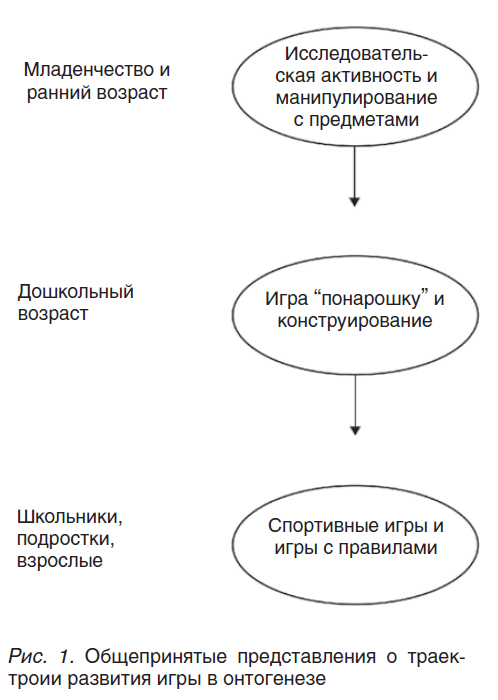
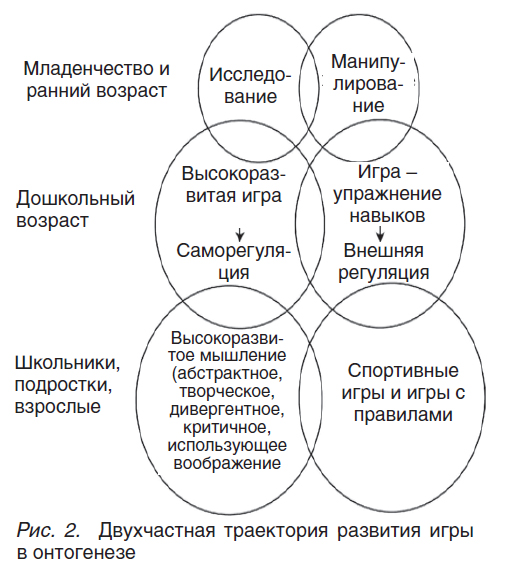
Высокоразвитая игра (также называемая творческой, сложной или зрелой игрой) и игра–отработка навыков являются как следствием, так и источником из разных сфер развития, хотя, как любые виды человеческой деятельности, они не полностью изолированы друг от друга. Высокоразвитая игра лежит в основном в сфере абстрактного/рефлексивного мышления и воображения (преимущественно внутренней), тогда как игры с правилами и спортивные игры являются частью сферы навыков и умений (преимущественно внешней). Последний тип развивается из предметных манипуляций, практической игры и подвижных занятий, таких как бег, догонялки, лазание, езда на велосипеде, складывание мозаики и т. п. Среди дошкольников довольно распространена комбинированная игра, когда оба типа игры накладываются или быстро сменяют друг на друга. Например, ребенок начинает строить из конструктора домик по инструкции, но постепенно переключается на свои фантазии о том, каким должен быть дом (врезка). В кратко-срочной перспективе высокоразвитая игра развивает саморегуляцию у дошкольников, в долгосрочной перспективе она преобразуется скорее в воображение, творческое, абстрактное и индуктивное мышление, а также в способность к выражению своих мыслей, нежели в игру с правилами или социальные навыки. Высокоразвитая игра – путь к высокоразвитому мышлению. «Игра идей» – это одно из многих выражений в английском языке, которое явно указывает на родство игры и высших психических функций.
Высокоразвитая игра
• В основном задействует мышление и воображение
• Правила являются вторичными, скрытыми, интернализированными, не озвучиваются
либо могут быть предметом обсуждения
• Некоторые виды данной игры носят исследовательский характер
• Игры-драматизации, игры «понарошку» с понятными ролями и сценарием
• Режиссерская игра (драматизации игровых сценариев с игрушками или
предметами)
Игра – отработка навыков
• В основном представляет собой упражнение умственных или двигательных
навыков
• Правила доминируют и существуют в явном виде
• Катание (на самокате, велосипеде и др.)
• Настольные игры и головоломки
• Разыгрывание сценария, рассказа, сказки
• Различные виды спорта
Комбинированная игра
• Содержит в себе элементы и высокоразвитой игры, и игры – упражнения навыков
либо представляет собой переключение между этими двумя типами
• Часто зависит от способа использования ребенком игрового материала
• Занятие, связанное с освоением навыка, но включенное в сценарий игры
(например, дети катаются на велосипедах и при этом играют, что они
лошади)
• Конструирование (например, из Лего ™, кубиков) не по заданной
инструкции
• Импровизации на основе сценария, рассказа, сказки
Рис. 3. Ключевые элементы двухчастной теории игры
Конечно, в играх с правилами и спортивных играх есть элементы творчества: самые выдающиеся игроки – это те, кто, при равных физических данных, креативнее своих товарищей по команде. А развитые моторные и познавательные навыки нужны для самовыражения, чтобы оно доставляло удовольствие как «актеру», так и «зрителям». На обе сферы также влияют врожденные и наследственные предпосылки – утонченная способность к восприятию тональности звука помогает музыканту, а быстрота реагирования – спортсмену, но сами по себе они могут развиваться или пропасть втуне.
При помощи методов визуализации работы мозга было наглядно продемонстрировано, что творческая деятельность и деятельность, связанная с отработкой навыков, задействуют разные отделы мозга [Balzac, 2006; Berkowitz, 2009; Halsband, 2006; Heilman, 2003].
Чтобы понять, есть ли преимущества в использовании данной двухчастной теории игры, потребуются дополнительные эмпирические подтверждения. Самым релевантным было бы исследование отделов мозга, которые активизируются, когда дети заняты высокоразвитой игрой, другими видами игры, различными неигровыми видами деятельности, и выявление того, различаются ли они, и если различаются, то каким образом. Далее потребуется сравнение выявленных активных зон мозга с зонами, которые активизируются у детей более старшего возраста во время занятий, требующих сложных форм мышления, спортивных и настольных игр, чтобы обнаружить существование и направленность корреляций.
Подтверждения данной теории возможно получить в ретроспективном исследовании взрослых, которое помогло бы определить наличие связи между тем, сколько времени испытуемые проводили за высокоразвитой игрой, будучи дошкольниками, и тем, каковы их наличные способности к творческому и критическому мышлению и к решению проблем. Наконец, если недостаток игры вредит детскому развитию, то углубленные занятия высокоразвитой игрой должны приносить пользу.
Высокоразвитая игра в образовании
Не всякая игра «понарошку», фигурирующая в программах развития в раннем детстве, является высокоразвитой игрой. Она подразумевает совместную работу детей по развитию связной истории, позитивное и продуктивное взаимодействие, использование игровых и других вспомогательных материалов, обсуждение ролей и действий, полную вовлеченность в воображаемую ситуацию. Развитие форм игры в раннем детстве можно представить в виде континуума, на одном конце которого находятся простейшие неорганизованные игровые действия, таких как возня, манипулирование с предметами, а на другом – высокоразвитая игра.
Развитие высокоразвитой игры требует от учителя высокой квалификации, способности распознать актуальный уровень развития игры у ребенка и поощрять его к дальнейшим шагам. Чтобы сочинять и развивать игровые сценарии, наполненные смыслом и увлекательные для детей; чтобы поддерживать и углублять игру, не присваивая себе контроль над ходом игры, от педагога требуются творческие способности, хорошее образование и опыт.
Поддержка высокоразвитой игры – это ключ к качественному обучению не только в раннем детстве, но и на протяжении всего школьного обучения. Причем происходящие с возрастом изменения – в основном внешние. По мере взросления ребенка «игра» интернализируется, и дети мысленно играют с идеями, понятиями, визуальными образами – собственными и почерпнутыми в литературе, у учителей и сверстников. Высокоразвитая игра – это одна из стратегий, используемых лучшими преподавателями естественных наук, чтобы углубить понимание старшеклассниками законов физики путем лабораторных исследований. Цель преподавания на каждом этапе одна и та же: привести учеников к игре, в которую они вовлекаются, в которой взаимодействуют со смыслами и идеями.
Выводы
В данной публикации была предпринята попытка помочь сфере обучения в раннем возрасте оценить важность игры для образования и внедрить учебный план, основанный на игре, в практику, которая нашла бы поддержку как специалистов, так и широкого социума. Этого можно достичь, если осмыслить высокоразвитую игру у дошкольников как один из важнейших источников высших психических функций, необходимый для успешного обучения в школе, а не как предпосылку для овладения спортивными играми и играми с правилами (которые часто оцениваются как досуговая, «бесполезная» деятельность), а также заострить внимание на концептуальной близости игры и лучших практик преподавания и учения на протяжении всего образовательного марш-рута.
Такое понимание игры должно вести к более вдумчивому и осознанному подходу к игре в раннем детстве, что, несомненно, послужит во благо детского развития. Утверждения в духе «игра – это дело для детей» обесценивают усилия по поддержке игры в обучении, потому что не все детские игры имеют одинаковую ценность для развития. Поэтому игра – развитие высокоразвитой игры – это не «детское дело», а работа учителя.
Приложение
Опросник представлений об игре
Меня интересует ваше понимание места игры в развитии ребенка. Это поможет мне в работе над статьей по данному вопросу. Опросник очень небольшой, его заполнение займет у вас несколько минут. Спасибо.
1. Младенцы и дети раннего возраста (от 0 до 2 лет) играют в исследовательские/манипулятивные игры (ощупывание, обсасывание, манипуляции с предметами) и простейшие социальные игры (ку-ку, догонялки).
• Я согласен с данным утверждением
• Я не согласен с данным утверждением или его частью
Если вы не согласны с данным утверждением или его частью, пожалуйста, объясните почему:
______________________________________________________________
2. Дошкольники (от 3 до 5 лет) за счет более развитых речевых и когнитивных навыков переходят к более сложным, но все еще незамысловатым социальным играм (прятки), играм «понарошку» (в одиночку с куклами или разыгрывание придуманных сценариев с друзьями) и конструированию (строительство из кубиков и конструктора).
• Я согласен с данным утверждением
• Я не согласен с данным утверждением или его частью
Если вы не согласны с данным утверждением или его частью, пожалуйста, объясните почему:
______________________________________________________________
3. У школьников и подростков игра трансформируется в:
______________________________________________________________
______________________________________________________________
______________________________________________________________
4. Каковы источники ваших представлений о месте игры в развитии ребенка? Выберите не более двух основных источников.
• Лекции, воркшопы
• Учебники
• Профессиональная литература
• Статьи из журналов
• Личный опыт общения с детьми
• Другое (что именно?)
5. Каков ваш образовательный уровень?
• Законченное среднее образование
• Прошел обучение в Child Development Association
• Среднее специальное или неоконченное высшее
• Бакалавр
• Магистр
• Имею ученую степень
6. Какую должность вы занимаете в данный момент?
• Педагог по работе с младенцами и детьми раннего возраста
• Педагог детского сада
• Педагог дошкольной подготовки
• Педагог начальной школы (1–5 классы)
• Административный сотрудник
• Консультант / тренер
• Исследователь
• Другое (что именно?)
